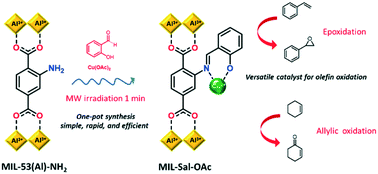Microwave-assisted one-pot functionalization of metal–organic framework MIL-53(Al)-NH2 with copper(ii) complexes and its application in olefin oxidation
Abstract
A simple, rapid, and efficient functionalization of the metal–organic framework MIL-53(Al)-NH2 with copper(II) complexes by microwave irradiation is described. The one-pot post-synthetic modification was based on the Schiff base reaction between the aldehyde added and the primary aryl amino group in the organic linker of MIL-53(Al)-NH2, which afforded coordination sites for copper(II). The effects of synthetic parameters such as solvent, reaction time, and reactant ratio were evaluated. The functionalized materials were structurally characterized and examined for potential applications in catalysis. The copper complex functionalized MIL-53(Al) was active towards the oxidation of olefins with tert-butyl hydroperoxide as an oxidant. The results showed that if the olefin possessed allylic hydrogens such as cyclohexene, allylic oxidation products were obtained, but epoxide was the major product obtained from terminal olefins without allylic hydrogens. The reaction mechanism based on density functional theory calculations provides some insights into the observed experimental results.



 Please wait while we load your content...
Please wait while we load your content...